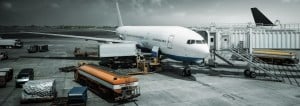 With aeroplanes increasing in size, and 38,000 new aircraft to be introduced into the global fleet within next 20 years (statistic Boeing July 2015), airports are beginning to feel the impact of larger aircraft on the apron and airside.
With aeroplanes increasing in size, and 38,000 new aircraft to be introduced into the global fleet within next 20 years (statistic Boeing July 2015), airports are beginning to feel the impact of larger aircraft on the apron and airside.
Airports must plan and prepare for the impact of new planes coming into the market, particularly jumbo planes such as the A380. For these jumbo planes, although the weight and size of plane does not cause stress on all runways (either in terms of size and weight), it does impact on all taxiways, parking, terminal space and passenger demand.
A larger plane needs larger taxiways, a larger parking bay, a larger hangar for maintenance and more gangways to cope with the increased amount of passengers entering and exiting the aircraft. With the A380 capable of carrying up to 853 passengers in an all-economy class configuration, there also needs to be revisions within immigration, airport security screening and airport baggage handling to deal with increased demand from these flights.
This will impact on activities within the airside and apron of any airport and airports must plan and prepare for the new planes coming into the market. As well as the structural and space aspects, there is also a requirement for demand forecasting to deal with increasing passenger numbers to ensure efficiency and to meet guidelines.
AiQ Consulting’s Holistic and High-Level strategic consultancy service can help airports cope with increased demands from growing aircraft fleets, both in terms of size and frequency. Our experience in airport capacity planning and airport operations allows us to recognise current and future demand and capacity within your airport schedule, and then apply our skills, tailored to your problems and goals.
From airport demand forecasting, masterplanning, process design or operational efficiency, we work with airports all over the world to ensure that they meet passenger demand, now and in the future. To find out more, please contact us

